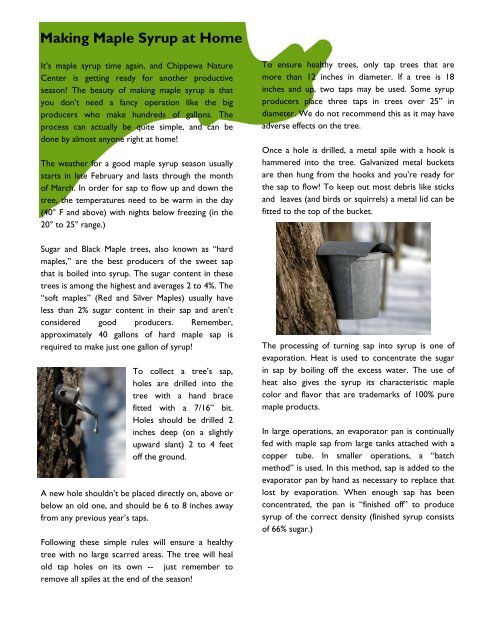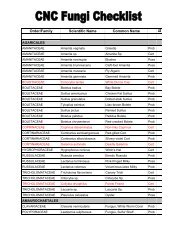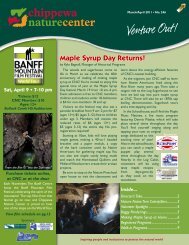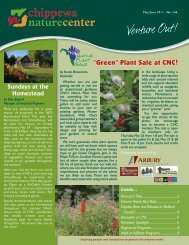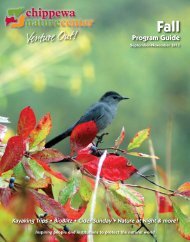Making maple syrup at home - Chippewa Nature Center
Making maple syrup at home - Chippewa Nature Center
Making maple syrup at home - Chippewa Nature Center
You also want an ePaper? Increase the reach of your titles
YUMPU automatically turns print PDFs into web optimized ePapers that Google loves.
<strong>Making</strong> Maple Syrup <strong>at</strong> Home<br />
It’s <strong>maple</strong> <strong>syrup</strong> time again, and <strong>Chippewa</strong> N<strong>at</strong>ure<br />
<strong>Center</strong> is getting ready for another productive<br />
season! The beauty of making <strong>maple</strong> <strong>syrup</strong> is th<strong>at</strong><br />
you don’t need a fancy oper<strong>at</strong>ion like the big<br />
producers who make hundreds of gallons. The<br />
process can actually be quite simple, and can be<br />
done by almost anyone right <strong>at</strong> <strong>home</strong>!<br />
The we<strong>at</strong>her for a good <strong>maple</strong> <strong>syrup</strong> season usually<br />
starts in l<strong>at</strong>e February and lasts through the month<br />
of March. In order for sap to flow up and down the<br />
tree, the temper<strong>at</strong>ures need to be warm in the day<br />
(40° F and above) with nights below freezing (in the<br />
20° to 25° range.)<br />
Sugar and Black Maple trees, also known as “hard<br />
<strong>maple</strong>s,” are the best producers of the sweet sap<br />
th<strong>at</strong> is boiled into <strong>syrup</strong>. The sugar content in these<br />
trees is among the highest and averages 2 to 4%. The<br />
“soft <strong>maple</strong>s” (Red and Silver Maples) usually have<br />
less than 2% sugar content in their sap and aren’t<br />
considered good producers. Remember,<br />
approxim<strong>at</strong>ely 40 gallons of hard <strong>maple</strong> sap is<br />
required to make just one gallon of <strong>syrup</strong>!<br />
To collect a tree’s sap,<br />
holes are drilled into the<br />
tree with a hand brace<br />
fitted with a 7/16” bit.<br />
Holes should be drilled 2<br />
inches deep (on a slightly<br />
upward slant) 2 to 4 feet<br />
off the ground.<br />
A new hole shouldn’t be placed directly on, above or<br />
below an old one, and should be 6 to 8 inches away<br />
from any previous year’s taps.<br />
Following these simple rules will ensure a healthy<br />
tree with no large scarred areas. The tree will heal<br />
old tap holes on its own -- just remember to<br />
remove all spiles <strong>at</strong> the end of the season!<br />
To ensure healthy trees, only tap trees th<strong>at</strong> are<br />
more than 12 inches in diameter. If a tree is 18<br />
inches and up, two taps may be used. Some <strong>syrup</strong><br />
producers place three taps in trees over 25” in<br />
diameter. We do not recommend this as it may have<br />
adverse effects on the tree.<br />
Once a hole is drilled, a metal spile with a hook is<br />
hammered into the tree. Galvanized metal buckets<br />
are then hung from the hooks and you’re ready for<br />
the sap to flow! To keep out most debris like sticks<br />
and leaves (and birds or squirrels) a metal lid can be<br />
fitted to the top of the bucket.<br />
The processing of turning sap into <strong>syrup</strong> is one of<br />
evapor<strong>at</strong>ion. He<strong>at</strong> is used to concentr<strong>at</strong>e the sugar<br />
in sap by boiling off the excess w<strong>at</strong>er. The use of<br />
he<strong>at</strong> also gives the <strong>syrup</strong> its characteristic <strong>maple</strong><br />
color and flavor th<strong>at</strong> are trademarks of 100% pure<br />
<strong>maple</strong> products.<br />
In large oper<strong>at</strong>ions, an evapor<strong>at</strong>or pan is continually<br />
fed with <strong>maple</strong> sap from large tanks <strong>at</strong>tached with a<br />
copper tube. In smaller oper<strong>at</strong>ions, a “b<strong>at</strong>ch<br />
method” is used. In this method, sap is added to the<br />
evapor<strong>at</strong>or pan by hand as necessary to replace th<strong>at</strong><br />
lost by evapor<strong>at</strong>ion. When enough sap has been<br />
concentr<strong>at</strong>ed, the pan is “finished off” to produce<br />
<strong>syrup</strong> of the correct density (finished <strong>syrup</strong> consists<br />
of 66% sugar.)
CNC Volunteer Herm Gieseler demonstr<strong>at</strong>es the old<br />
fashioned b<strong>at</strong>ch method <strong>at</strong> Maple Syrup Day<br />
To begin the evapor<strong>at</strong>ion process, fill a large shallow<br />
pan with sap (traditional kettles or large saucepans<br />
can also be used.) He<strong>at</strong> the sap to the boiling point,<br />
taking care not to burn or scorch it in the bottom of<br />
the pan. It is important to have adequ<strong>at</strong>e ventil<strong>at</strong>ion<br />
in the room when boiling, as large quantities of<br />
steam are cre<strong>at</strong>ed in this process!<br />
As the level of sap in the pan is lowered through<br />
evapor<strong>at</strong>ion, just add more sap to the bubbling pan.<br />
This process is continued until most of the sap is<br />
highly concentr<strong>at</strong>ed and its temper<strong>at</strong>ure begins to<br />
rise above the boiling point of w<strong>at</strong>er. (Throughout<br />
the boiling process you may occasionally need to<br />
skim the surface of the boiling liquid to remove<br />
surface foam and other m<strong>at</strong>erials.)<br />
Finished <strong>syrup</strong> is cre<strong>at</strong>ed when the temper<strong>at</strong>ure of<br />
the boiling sap is seven degrees above the boiling<br />
point of w<strong>at</strong>er (usually about 219° F.) As the boiling<br />
sap approaches this temper<strong>at</strong>ure, it is very important<br />
to carefully monitor the pan to prevent burning and<br />
overhe<strong>at</strong>ing. It is best to use a candy thermometer<br />
calibr<strong>at</strong>ed to <strong>at</strong> least 227° F to monitor the boiling<br />
sap.<br />
Drawing off a b<strong>at</strong>ch of finished <strong>syrup</strong> from CNC’s<br />
modern evapor<strong>at</strong>or pan in the Sugarhouse<br />
One you reach the finishing point of your b<strong>at</strong>ch, the<br />
<strong>syrup</strong> is ready for filtering and packaging. To ensure<br />
a pure product, <strong>syrup</strong> should be run through a wool<br />
filter when hot to remove any suspended particles<br />
(such as “sugar sand.”) Before canning, the <strong>syrup</strong><br />
should be he<strong>at</strong>ed to <strong>at</strong> least 180°F to kill any bacteria<br />
th<strong>at</strong> may cause it to spoil.<br />
The process of making <strong>maple</strong> <strong>syrup</strong> is a fun and<br />
rewarding activity th<strong>at</strong> can be enjoyed by almost<br />
anyone. If you have any questions about <strong>maple</strong><br />
<strong>syrup</strong>-making, we invite you to call us for<br />
inform<strong>at</strong>ion <strong>at</strong> (989) 631-0830.<br />
www.chippewan<strong>at</strong>urecenter.org


